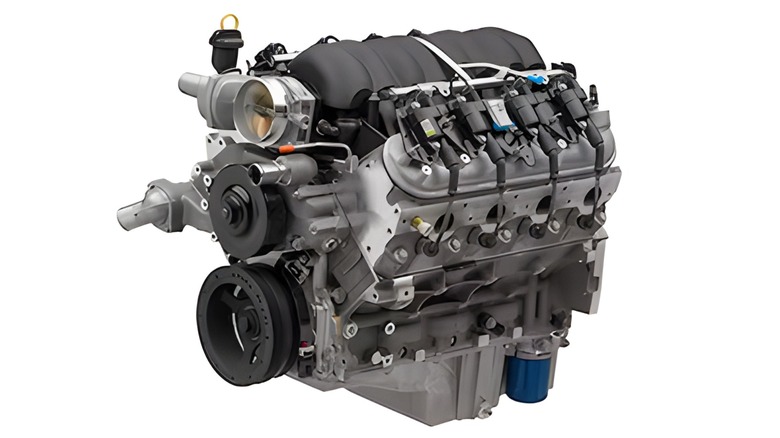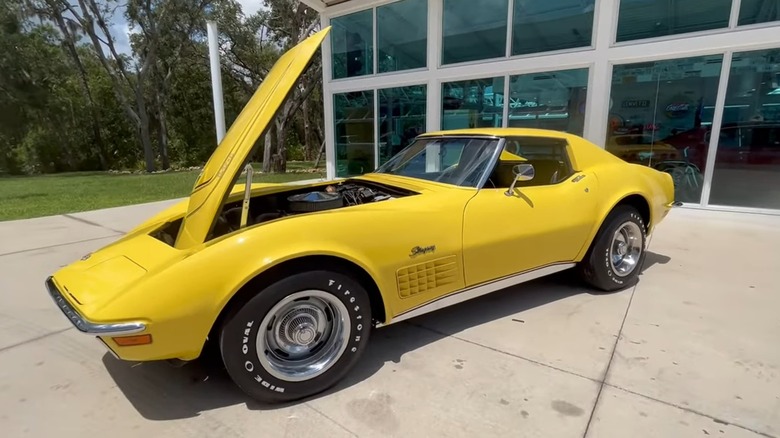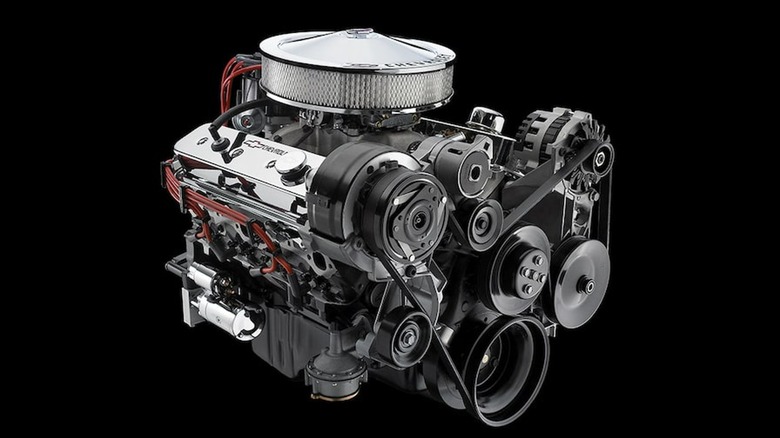The Best And Worst Years For The Chevy 350 V8 Engine
Internal combustion engines have fascinated gearheads and techies since their rise to popularity in the early 20th century. But not all engines receive the same love and admiration. Many enthusiasts adamantly proclaim that engines produced by their preferred automaker are the best — e.g., Ford fans may hold the Ford Coyote V8 above all other motors, while Mopar diesel fanatics claim the Cummins engine is the best ever.
Regardless of where you stand in the Ford versus GM versus Mopar versus import debate, some motors are undeniably special. The Chevy 350 V8 is one of those uniquely special motors and is, in fact, one of the most popular engines ever made. The motor's various iterations powered GM vehicles between 1967 and 2002 — including iconic vehicles like the 1967 Chevy Camaro and various Chevy Corvette models — and it remains an incredibly popular engine among enthusiasts, ranging from diehard gearheads to casual drivers.
It's known for its intense reliability, power, and versatility. Fans around the world prize the Chevy 350, and drivers of all interests, from racers and tuners to those who use their rides for heavy-duty work, choose the legendary motor for swaps and custom builds. But while the Chevy 350 is famed for durable, long-lasting performance and intense versatility, not all model years are equal. The 1970 LT-1 version is generally considered one of the best of all the iterations. However, a couple of other versions make the list when it comes to the best Chevy 350 years, while several others fall into the category of the worst versions.
The best years
When it comes to the best years for the Chevy 350 V8, three motors, in particular, stand out: the 1970 LT-1, the 1992 L98, and the 2002 L31.
Like many older engines, the 1970 LT-1 is prized, in part, for its lack of emissions control devices. In the early years of emissions control systems, these parts were infamous for drastically reducing a motor's power output and reliability. The 1970 LT-1 arrived on the scene just before the advent and widespread implementation of these emissions components. It was capable of producing 370 horsepower and was built with various high-performance components, making it highly reliable and powerful.
Between 1971 and 1991, the Chevy 350 V8 underwent a series of modifications to comply with new emissions guidelines. During this time, the 350 remained a solid engine, but its power levels dropped substantially as a result of modern emissions systems. That all changed in 1992 with the release of the L98 engine. The L98 revitalized the small block 350, transforming it into an emissions-compliant beast capable of producing high levels of torque and 250 horsepower without pumping the air full of toxins or burning obscene amounts of fuel.
Appropriately, the final engine to make the list of the best Chevy 350 years is also the last small block 350 that GM built for production cars. These motors were known to be extremely reliable. Chevy had such faith in the L31 engine that it offered 100,000-mile warranties on the entire engine for its 2500 and 3500 pickup trucks. The motor is easy to modify and features many similarities to the older and highly desired LT-1 engine, while its modern design and technology make it incredibly reliable, durable, and an extremely popular choice for engine swaps.
The worst years
The Chevy small block 350 is an iconic engine that has stood the test of time to become one of the most popular motors that Chevy ever built. However, it's not perfect. And if you're searching for a Chevy 350 for your custom build or restoration project, there are some model years that you should avoid. As with many classic engines, some of the most problematic years are due to emissions control innovations. When these systems were first released, they were known for being points of failure and causing power loss, resulting in a less robust and reliable engine.
For the Chevy small block 350 motors produced during much of the '70s and '80s, emissions control systems left the engines riddled with performance issues. Chevy 350 motors across the board saw power outputs drop drastically during this time due to the implementation of newly designed emissions control systems. Luckily, by the early 1990s, GM figured out its emissions system issues, and the small block 350 rose once again to unparalleled fame and popularity in the world of gearheads.
Thanks to the issues caused by the development of emissions control systems in the 1970s and '80s, you should avoid these model years if possible. GM still produces small block 350 crate motors. So, if you're in the market for a classic engine for a restoration or custom build, you don't even have to hunt down a used one. But if you do choose to buy used, remember to avoid the '70s and '80s and search for one of the three best versions covered above.


